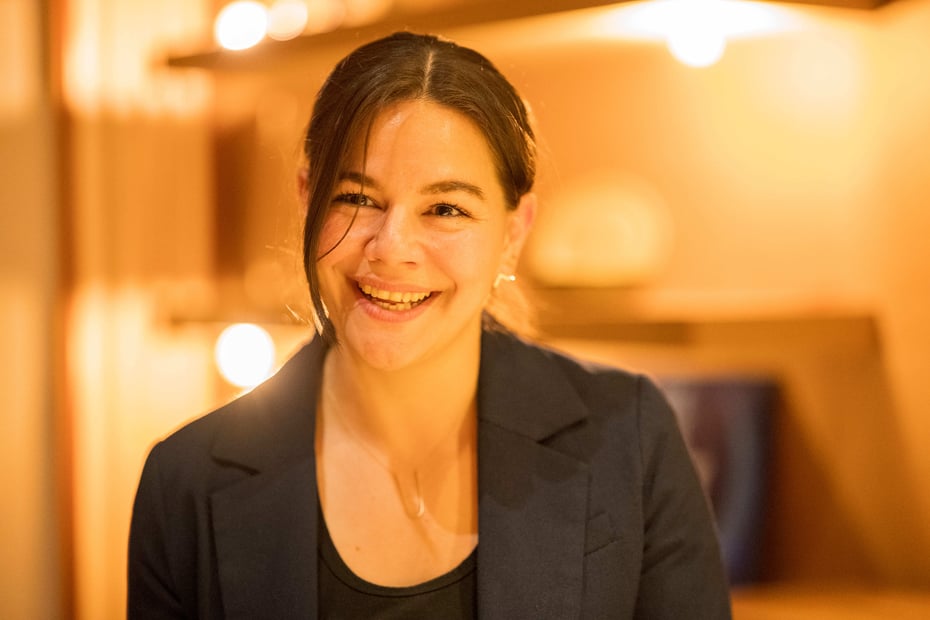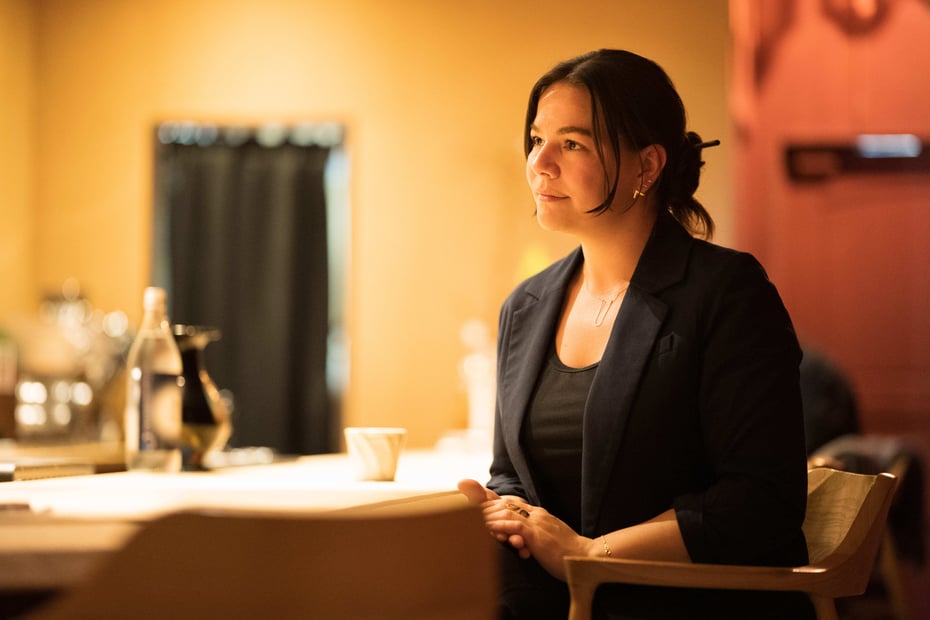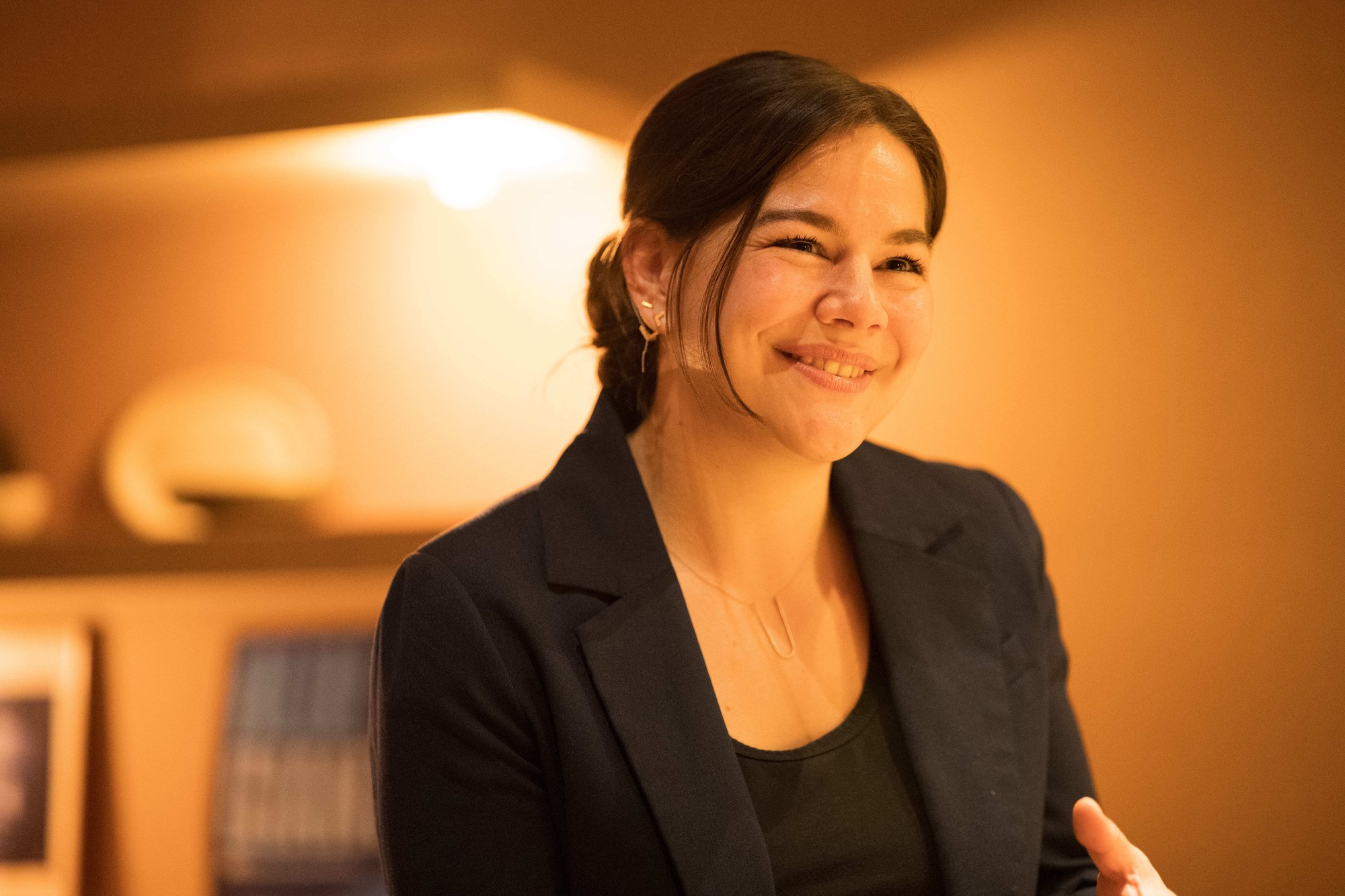Part 2: Employee Well-Being Is the
Top Priority. That Leads to Better
Customer Service
The bar kumiko opened in Chicago in 2018. It attracted attention for its unique style of serving personalized cocktails that also go with each customer’s meal. But in 2020, the pandemic forced restaurants to temporarily close. During that time, the bar industry faced a serious business crisis. Julia and two of her associates launched Cocktails for Hope, a campaign petitioning Chicago’s municipal authorities for permission to sell take-out cocktails. That permission was granted as a result of their tenacious negotiations, and the policy went a long way in helping bars stay in business. In Part 2 of this interview, we asked Julia Momosé about the concept behind her bar’s name and her memories of her social action.
⇒ Read Part 1: “A Bartender’s Beautiful Movements Resemble a Ballet Dancer”
Text: Akira Suzuki / Photography: Koichi Mitsui / Composition: Contentsbrain / English translation: LIBER
Interview Location: Bar Tannel (1-12-2 Kitahama, Beppu-city, Oita, Japan)
I Value the Time and Process Leading
to the Finished Product
You had a goal of opening your own place by age 30, right?
Yes. Kumiko opened in 2018 on New Year’s Eve. I turned 30 the next month, so I barely made it. (Laughs.)
Why did you decide to name your bar kumiko?
I had a lot of trouble trying to choose the name, so I wrote down the policies for the bar: passion and meticulous care, cooking with natural ingredients and focusing on long proven techniques instead of modern ones, and placing importance not on the finished cocktail or dish, but on the time and process to get there.

The name kumiko comes from kumiko-zaiku, a kind of traditional Japanese woodworking⋆1. The kumiko-zaiku process starts with the wood. After you plant a seed, it takes decades for a tree to grow. When you fell it, you can’t use the timber right away because you have to let it dry for a few years. That patience is important. The artisans who carve the wood into intricate patterns have to work and practice for years before they can finally produce their beautiful creations. That’s amazing to me, and I chose the name kumiko because the kumiko-zaiku approach ties in with the bar’s policy.
⋆1 Kumiko-zaiku: Traditional Japanese woodworking in which elaborate patterns are created by manually assembling thin boards and pieces of wood one at a time without the use of nails or other fasteners. Used for interior decoration.
Likewise, Sanwa Shurui’s wonderful, honkaku barley shochu (single distillation barley shochu) is made from barley that farmers grow and harvest. The brewer uses that barley and quality water in a number of processes to create the final product. Before the shochu reaches us, considerable time and effort goes into its production. I think it’s important to think about that when making cocktails. I research where every ingredient–ice, fruit, juice, and spirits–comes from and I respect its origin as I shape the cocktail experience. That’s how I work, and how I am inspired.
There are two panels behind the bar. If you look at them, I think you’ll understand what kumiko-zaiku is. The patterns are asanoha (hemp leaves) and goma (sesame seeds). Each has its own meaning. Hemp leaves are said to ward off evil, while sesame seeds are supposed to bring good health and happiness. I keep this in mind when serving cocktails at kumiko. The kumiko-zaiku panels at the bar express my hope that the customers will live long and happy lives after enjoying delicious food and drink in a safe place.
The Employees Are What
Makes Bar kumiko Special
As the owner of a bar, what are the kinds of things that concern you on a day-to-day basis?
The well-being and safety of my team is paramount. A woman working the bar may receive inappropriate comments or get irritated by her male coworkers-it has happened to me. At kumiko, I think the employees are my most important asset and I want to protect them. They are what makes kumiko special.
A safe workplace environment allows employees to provide better customer service. If an employee is worried about their safety, they can’t think about the guests. I want us to feel comfortable and focused so we can offer wonderful service. We take care of each other first. Then we can take better care of our guests.
I’m not too tough a boss, but I’m not too lenient, either. (Laughs.) I do ask a lot. I have high expectations. But most of all to myself. I think mutual respect is important, so I try to make kumiko an intentional place where we can also be serious and honest, but also have a good time.
What inspired the concept of entertaining customers by pairing Japanese cuisine with cocktails?
Personally, I’ve always liked wine bars and dining bars; places where you can eat and drink, pairing your food with beverages. There are lots of places like that for wine and beer, but there weren’t many where you could pair cuisine with cocktails. That’s why I wanted to make cocktails with a relatively low alcohol content, with recipes based on honkaku shochu and sake and other Japanese ingredients, paired with food.
When we first opened, we put out a tasting menu at the bar counter. We prepared about six different drinks to pair with each dish, including wine, beer, and a few cocktails, along with spiritfree recipes. We had no more than eight or so guests at a time, so we would chat with each one, ask what kinds of drinks they like, whether they preferred strong or weak drinks, and so on. We’d then create personalized pairing menus. Everyone would have the same food, but paired with different drinks. It was quite a challenge, but also lots of fun. This experience earned us a Michelin Star.
Facing the Pandemic
It was right then that the Covid pandemic began. That was a really tough time. On March 13, 2020, the U.S. declared a national emergency. On March 17, all bars and restaurants were ordered to close. Those of us in the restaurant industry didn’t know what to do. We were at a loss.
Since people couldn’t drink cocktails in bars, owners like me wanted to sell take-out cocktails. But that was against the law in Chicago. One official said the mayor would make a decision on the issue, but Illinois state commissioners of commerce, community, and economic development said that they would determine the law.. We were getting different messages from different places.
If nothing was done, the city’s bars would have gone under.
I felt like I needed to do something, so I started the Cocktails for Hope campaign seeking permission to serve take-out drinks. One of kumiko’s regular customers and a lawyer familiar with the restaurant industry joined me in this effort. We collected signatures to submit a petition and delivered a letter to the Governor of Illinois. Next, we produced a video calling attention to the desperate situation for bars. After we released it, an Illinois official contacted us to discuss the matter.

Around that time, the media finally took notice of our plight and wrote articles about it. We started getting phone calls from lots of different people who helped with our petition drive. A senator drafted a bill and submitted it to the legislature. In June, three months after the state of emergency was declared, we got a law passed that allowed Chicago bars to sell bottled cocktails with a label and a seal.
It must have required considerable courage to start that campaign. The three of you worked really hard.
I was afraid when we first started the campaign. But while workers laid off from American companies were receiving unemployment benefits, bartenders mostly work for tips and our wages are low in the first place, so without work, we couldn’t get enough money. I wanted to help workers not just at my bar, but at all of Chicago’s bars. When I thought about that, it gave me courage. I could put in the effort because I was doing it for everyone, not just me.
Cocktails Made with Shochu
You mix cocktails with shochu. What do you think about shochu’s potential in the U.S. market?
Shochu still doesn’t have great name recognition outside of Japan. In the U.S., you see it more than you did five years ago, but I think it’s still got a long way to go. If you use it in a cocktail, it is an opportunity. You’ll probably get a casual question like, “Oh, this is good. What’s in it?” Then, you can tell them it’s shochu.
Bar kumiko’s first floor is a Japanese-style dining bar, while the bar in the basement serves Japanese whisky and shochu at a counter. Guests are guided towards these special Japanese spirits. That makes me really happy. I think shochu is finally getting recognition alongside our a la carte food menu-at least at those ten bar seats.
How do your customers react the first time they drink shochu?
They’re often quite surprised. Many people don’t know about shochu, so they think it’s Japanese vodka or whisky. But shochu is a spirit that lets you taste the flavor of its ingredients, whether it’s barley or sweet potato. This delights my guests. They say that shochu is delicious, unique, and easy to drink.

In the U.S., it must be hard to explain what koji is or the koji fungus (also known as koji mold) used to make it.
It’s called “mold” in English, but if you say that, at first it scares people. In America, it’s not a word you want to use. But if you say, “It’s used for miso and soy sauce,” that makes a different impression and they’ll feel okay about drinking it. If you talk about how there are different types of mold used to make koji, such as yellow, black, or white koji fungus, and how different types of mold result in shochu with totally different tastes and flavors, that will get people interested.
There would be no shochu without koji, so it’s a very important ingredient. Shochu is generally 25% alcohol, but it’s impressive that you can enjoy the flavor even if it’s mixed with water. When you mix spirits like whisky or rum with water, sometimes you just dilute the flavor.
Shochu goes well with water despite its alcohol content, a testament to the complexity of koji spirits. Of course it tastes good in cocktails too, but I want people to also know how good it tastes if you simply mix it with hot water or green tea. I also want them to try drinking it straight. These traditional Japanese serves truly allow shochu to shine. I do believe that we have the opportunity to create a new category of cocktails: shochu cocktails. It is an exciting concept.
There are many different types of shochu, so I think there’s one for everybody. Some people say it doesn’t taste very good, or they’re disappointed that it’s not Korean soju. I enjoy these conversations with customers. If they don’t like the taste of one shochu, I’ll recommend another. I often say, “There is always something for you.” While we chat, I find the right shochu for them. I think shochu’s variety will help spread its popularity.
⇒ Read Part 1: “A Bartender’s Beautiful Movements Resemble a Ballet Dancer”

Julia Momosé
Owner-bartender at Bar Kumiko
Born in Nara and raised in Kyoto. Lived in Japan through high school, then moved to the U.S. to attend Cornell University. Started her career as a bartender at Rulloff’s in Ithaca, New York. Moved to Baltimore, Maryland in 2010, where she got experience at RYE of Baltimore. Shined as a bar menu creator after a year and a half. In 2013, began a two-year stint at The Aviary in Chicago as a bar chef and top bartender. Later took a position at GreenRiver. While serving as head bartender there, GreenRiver earned its first Michelin Star. Managed the cocktail program at restaurant Oriole. Gained renown for her cocktail creations for Arriviamo™ Bar at Starbucks Reserve® Roastery. Opened kumiko in 2018 with her cofounder. In March 2020, during the pandemic, launched the Cocktails for Hope⋆² campaign to assist distressed bars in the Chicago area. The book she coauthored in 2021, “The Way of the Cocktail: Japanese Traditions, Techniques, and Recipes,” won a James Beard Foundation Award in 2022.
⋆² Cocktails for Hope: Around the end of March 2020, in the middle of the pandemic, Momosé led this campaign to assist bars. She ran a petition drive seeking to allow the sale of take-out cocktails that moved the City of Chicago to act and catch up with faster-moving cities like New York. The city allowed the sale of bottled cocktails, a decision that saved many Chicago bars.
